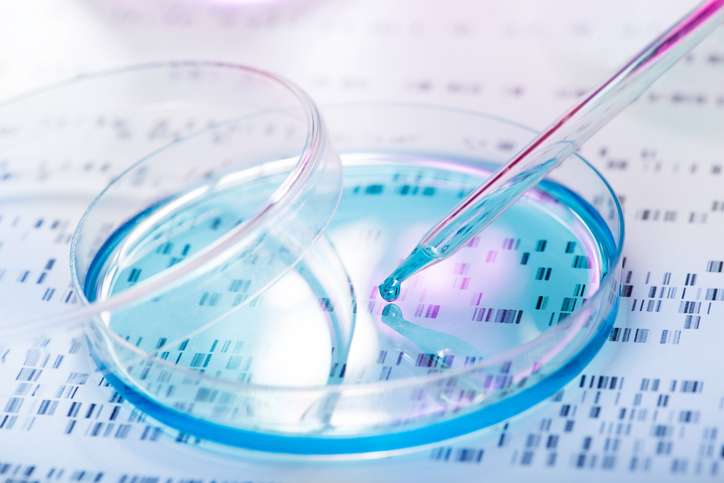Advanced therapy medicinal products (ATMPs) are medicines for human use that are based on genes, tissues or cells. They offer groundbreaking new opportunities for the treatment of disease and injury.
ATMPs can be classified into three main types:
- gene therapy medicines: these contain genes that lead to a therapeutic, prophylactic or diagnostic effect. They work by inserting ‘recombinant’ genes into the body, usually to treat a variety of diseases, including genetic disorders, cancer or long-term diseases. A recombinant gene is a stretch of DNA that is created in the laboratory, bringing together DNA from different sources;
- somatic-cell therapy medicines: these contain cells or tissues that have been manipulated to change their biological characteristics or cells or tissues not intended to be used for the same essential functions in the body. They can be used to cure, diagnose or prevent diseases;
- tissue-engineered medicines: these contain cells or tissues that have been modified so they can be used to repair, regenerate or replace human tissue;
In addition, some ATMPs may contain one or more medical devices as an integral part of the medicine, which are referred to as combined ATMPs. An example of this is cells embedded in a biodegradable matrix or scaffold.
For detailed definitions of the different groups of advanced therapy medicinal products, refer to Regulation (EC) No 1394/2007 and Directive 2001/83/EC.
In April 2020, EMA’sCommittee for Advanced Therapies (CAT) advised patients and the general public to beware of unproven cell-based therapies.
This followed the appearance of advertisements for cell therapies as cures for serious conditions across the European Union in early 2020.
In its statement, the CAT warned against the use of unregulated cell-based therapies, which may be ineffective and increase the risk of serious adverse reactions.
Healthcare providers should explain the benefits and risks of the cell-based therapies that they are providing to patients, as well as confirming that regulatory authorities have approved their use.
Anyone with doubts can contact EMA or their national competent authority.
The CAT’s statement replaces a statement it issued in 2010 following reports of unregulated stem-cell therapies being offered to patients.
 Somatic cell therapy medicinal products and tissue-engineered products (ATMPs)
Somatic cell therapy medicinal products and tissue-engineered products (ATMPs)
Somatic cell therapy medicinal products (sCTMPs) and tissue-engineered products (TEPs) are advanced therapy medicinal products (ATMPs). The main difference between sCTMPs and TEPs is determined on the basis of the intended use of the products. Therefore the intended use is part of the definition which is provided below. Both product types are reviewed by CCMO.
Somatic cell therapy medicinal products
Somatic cell therapy medicinal products contain cells or tissues that have been manipulated to change their biological characteristics, or cells or tissues not intended to be used for the same essential functions in the body. They are intended for the prevention, diagnosis and/or treatment of diseases via pharmacological, immunological or metabolic actions.
The full definition according to the European guidelines is as follows:
Somatic cell therapy medicinal product means a biological medicinal product which has the following characteristics:
- contains or consists of cells or tissues that have been subject to substantial manipulation so that biological characteristics, physiological functions or structural properties relevant for the intended clinical use have been altered, or of cells or tissues that are not intended to be used for the same essential function(s) in the recipient and the donor;
- is presented as having properties for, or is used in or administered to human beings with a view to treating, preventing or diagnosing a disease through the pharmacological, immunological or metabolic action of its cells or tissues.
More information can be found in Directive 2009/120/EC, Directive 2003/63/EC part IV and Directive 2001/83/EC Annex I part IV.
Tissue-engineered products
Tissue-engineered products contain cells or tissues that have been modified so they can be used to repair, regenerate or replace human tissue.
The full definition according to the European guidelines is as follows:
‘Tissue-engineered product’ means a product that:
- contains or consists of engineered cells or tissues
- Cells or tissues shall be considered ‘engineered’ if they fulfil at least one of the following conditions:
- the cells or tissues have been subject to substantial manipulation, so that biological characteristics, physiological functions or structural properties relevant for the intended regeneration, repair or replacement are achieved.
- the cells or tissues are not intended to be used for the same essential function or functions in the recipient as in the donor.
and:
- is presented as having properties for, or is used in or administered to human beings with a view to regenerating, repairing or replacing a human tissue.
More information can be found in article 2(1)(b) of the Clinical Trial Regulation (1394/2007/EG).
Image

The Center for Biologics Evaluation and Research (CBER) regulates cellular therapy products, human gene therapy products, and certain devices related to cell and gene therapy. CBER uses both the Public Health Service Act and the Federal Food Drug and Cosmetic Act as enabling statutes for oversight.
Cellular therapy products include cellular immunotherapies, cancer vaccines, and other types of both autologous and allogeneic cells for certain therapeutic indications, including hematopoetic stem cells and adult and embryonic stem cells. Human gene therapy seeks to modify or manipulate the expression of a gene or to alter the biological properties of living cells for therapeutic use. CBER has approved both cellular and gene therapy products – a list of these products may be found here.
Cellular and gene therapy-related research and development in the United States continue to grow at a fast rate, with a number of products advancing in clinical development. In addition to regulatory oversight of clinical studies, CBER provides proactive scientific and regulatory advice to medical researchers and manufacturers in the area of novel product development.
Regulatory Information
Donor Eligibility
Related Information
Sub-Topic Paragraphs
Products that appear promising in early clinical trials of somatic-cell or gene therapy will usually enter a commercial development process with two important parallel components. The safety and efficacy of the products are tested in clinical trials of appropriate design. Concurrently, the manufacture and testing of the biologic product itself are refined to permit large-scale production and distribution of a pure material with reproducible qualities. Although the clinical aspect of this process is the focus of public attention, the product-development component is equally important.
The need for appropriate control of biologic products has been recognized since their first large-scale use in the late 19th century. Therapeutic antiserums were found to be effective in treating certain infectious diseases, but their potency and purity varied widely. In 1901, 13 children in St. Louis died of tetanus after they had been injected with diphtheria antitoxin. Their deaths were traced to tetanus contamination of the equine serum from which the antitoxin was prepared13. This and other less dramatic incidents led to the enactment of the Biologics Control Act of 1902 — also known as the Virus, Serum, and Toxin Act — which mandated the federal regulation of biologic products14. Since that time, the manufacturers of biologic products have been required to hold licenses both for the product and for all manufacturing facilities.
The control of biologic products has been progressively refined since the 1902 act was passed. Three principles are central: control of the biologic source or sources, control of the production process, and control of the bulk and final product. These principles have been successfully applied to quality control for products as diverse as human blood and vaccines against viruses, and they are also crucial to controlling the quality of products for somatic-cell and gene therapy.
Products for somatic-cell and gene therapy may be derived from a variety of biologic sources, including directly harvested autologous, allogeneic, or xenogeneic cells; cultured cell lines; genetically modified cell lines; and viral vectors. Product safety requires that such sources be well characterized, uniform, distinguishable from the sources of similar materials, and not contaminated by hazardous adventitious agents. At the time of the 1902 act, the control of biologic materials centered around microbiologic testing and animal husbandry. The importance of such controls was illustrated when foot-and-mouth disease occurred in animals used to produce smallpox vaccine13. Subsequently, the development of new forms of technology, beginning with the production of viral vaccines by tissue culture, generated additional scientific challenges. Viral seed-lot systems, which set the permissible number of passages from the well-characterized parent virus through vaccine production, were developed to control potential reversion to virulence by attenuated viral strains. In addition, the concept of the production-cell substrate, a defined cellular source material used to produce biologic agents, was developed. Strategies were devised to test for contaminants originating in cell substrates — for example, the simian virus 40 found in the monkey-kidney-cell cultures used to produce poliovirus vaccine. Adventitious viruses continue to be a problem in today’s cell substrates. Currently, cell-banking and testing algorithms are used to evaluate the cell substrates used in the production of biologic agents such as vaccines, monoclonal antibodies, and recombinant-DNA products, as well as certain forms of somatic-cell and gene therapy.
Cells directly removed from humans may be used in somatic-cell and gene therapy and pose additional problems in preventing source-related contamination by adventitious agents. Safety issues related to the use of fresh cells first emerged with the advent of blood transfusion. Banking blood for transfusion saved countless lives during World War II, and whole blood subsequently became the first cellular material approved as a biologic product by the FDA. However, the widespread use of a human-derived cellular product raised unique issues of quality control related to the transfusion-associated transmission of disease. Because blood could not be sterilized by filtration or other means, the development of strategies to control or prevent viral and bacterial contamination was essential. As a result, the evaluation of donor health through history taking, physical examination, and laboratory testing became central to protecting the safety of the blood supply. The recent emergence of HIV reinforces the importance of donor screening and testing procedures when human-derived biologic materials are used.
The concept of controlling the manufacturing process is the second cornerstone in ensuring the quality of biologic products. Rigorous control of the process is essential because of the difficulties inherent in assessing and controlling the consistency of biologic products. Source materials, such as cells, viruses, and blood, are often not uniform. In addition, seemingly minor changes in the conditions of cell cultures or in purification processes may significantly alter the biologic characteristics of the final product. Because of the complex nature of final products that consist of cells, microorganisms, or macromolecules, testing of final products alone cannot reliably detect, test, or control for variability. Manufacturers must therefore rely on controlled, reproducible manufacturing procedures and environments to produce a uniform product. The degree of reliance on a controlled process varies according to the nature of the product. For example, in the case of certain products containing living cells that may be prepared in single-donor, single-recipient batches, the small size of each batch and the need for timely administration of the cells impose special limitations on testing. As a consequence, control over the process and the facility has been particularly emphasized.
The third central principle of controlling biologic products involves control of the bulk and final product. Because the complete chemical characterization of biologic products is not ordinarily feasible for quality control, the testing of biologic potency receives particular emphasis. Controlling the potency of somatic-cell therapies will be particularly challenging and will probably require the development of new approaches.
As the preceding examples demonstrate, control of the production of biologic agents has had a key role in quality assurance from the earliest biologic therapeutic agents through today’s scientifically complex interventions. The technical standards developed for the commercial production of somatic-cell and gene therapy will be based on these existing manufacturing and control principles.



